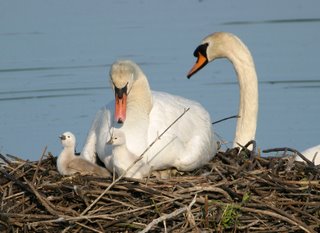
Excitement abounds at the Celery Farm Natural Area (Allendale, NJ) in the months of April and May. It’s migration season for warblers and just about everything else, so a video called “Birders Gone Wild” could easily be produced. An expert birder can easily spot (by sight and/or sound) a dozen or more warblers and scores of other species in one morning’s hike around the mile-plus perimeter of the preserve. My yield is usually embarrassingly smaller, but I enjoy the walk anyway.
This year is unique, however, because a pair of Mute Swans has chosen the Celery Farm’s lake for residency and nesting. And they graciously—one might even say miraculously--built their nest directly in front of one of the observation platforms, allowing visitors a perfect view of nest-building, egg-laying and young-rearing activities.
And activity there is. Two heavy rainfalls had both swan parents making emergency repairs as they tried to raise the nest and the eggs therein above water level. The work paid off, and their seven eggs are hatching this week. Photographers are crowding the platform to record the parents and cygnets in action—and to ooh and ah at each appearance of the babies from under the mother’s breast.
From my perspective, watching and listening to the birders, photographers and other types is almost as fascinating as watching and photographing the swans. Classifying the flock into various species of birders, photogs and hybrids thereof, as well as an occasional ecologist, zoo employee on maternity leave, or harried father with his accompanying horde, is a fun exercise in taxonomy and human behavior.
The photographers just want to get the shot and complain incessantly about bad light or an infernal protruding twig in the nest that threatens to spoil every shot.
The serious birders take a passing interest in the swans—they would rather snag warblers for their spring migration lists.
The cynics—not exactly rare birds themselves—opine that the snapping turtles are going to snag most of the cygnets once they hit the water. (Which is probably true, but that other breed, the kindergarten teacher, is repulsed by the thought.)
Then there was the ecologist-cynic hybrid who wrote to the local newspaper, complaining that we shouldn’t be happy about the presence of the Mute Swan, since it is an invasive alien species that will take over and wreak havoc on the ecology of the preserve.
It takes all kinds.
As for me, I can see a little of each of the described species in myself—which is why I need the Savior! As a Christian, I must look at every experience—even swan and people-watching—from a biblical perspective. So what am I to make of the whole Celery Farm scene?
First, I am overjoyed that a small patch of God’s creation has been preserved and thankful for the people who helped save it from development. That took perseverance by not a few people and the cooperation of local officials to make it happen in the face of intense pressure from real estate developers. For that, everyone, both Christian and unbeliever alike should be thankful.
Second, I am aware that the 107-acre bit of nature is a tiny piece of God’s fallen creation. It teems with examples of God’s creative handiwork—and the effects of that creation’s fall into sin and the resultant curse of the land. Evidence of intelligent design and irreducible complexity abound in every animal and plant and in the ecological relationships among them. But at every turn in the path there loom decay, deformity, disease, parasitism, predation and death—all unnatural phenomena, inimical to God’s perfect original sinless creation. Only by seeing both of these realities side by side and simultaneously can I have a balanced view and attitude toward the natural world.
When the snapping turtles snap and the swan family suffers loss—a realistic possibility—I will weep at the loss of God’s creatures because death is not natural; it is an enemy and the result of sin entering the world. But I will also know that in the end God will ultimately be glorified. I know that one death, that of the Lord Jesus Christ, conquered death in a very real sense. His death and resurrection actually accomplished the salvation of a particular group of people: His people, His sheep, His church, His elect. And in the end, there will be a resurrection of all, the believer to glorious eternal life, the unbeliever to eternal separation and woe. And there will be a “better than ever” version of God’s original “very good” creation for all believers to enjoy as we sing praises to our Lord and Savior.
Watching and photographing swans with old friends and new acquaintances has been a blessing. My prayer is that more of the whole swan-watching bunch would gain an appreciation of what those big white birds are--magnificently and intelligently designed parts of God's creation that show off both His creative power and His amazing grace in sustaining His sin-cursed cosmos.



